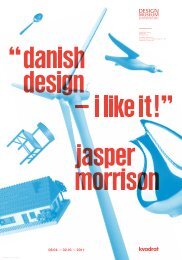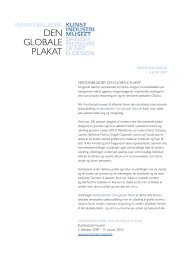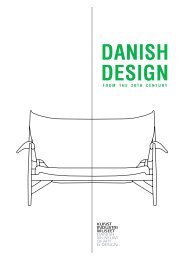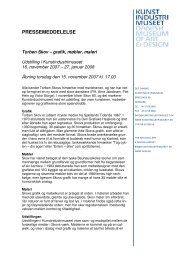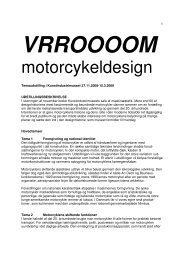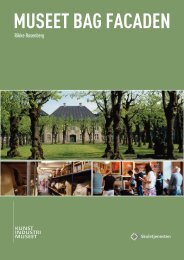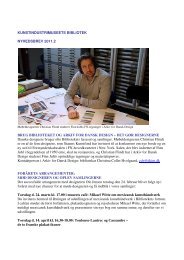Udstillingsfolder - Designmuseum Danmark
Udstillingsfolder - Designmuseum Danmark
Udstillingsfolder - Designmuseum Danmark
You also want an ePaper? Increase the reach of your titles
YUMPU automatically turns print PDFs into web optimized ePapers that Google loves.
KAJ FRANCK TEEMA MED VARIATIONER WITH VARIATIONS<br />
KAJ FRANCK KAJ FRANCK DEN INDUSTRIELLE PRODUKTIONS ÆSTETIK<br />
Kaj Franck (1911-1989) var en af de helt<br />
store finske designere, der udøvede en<br />
markant indflydelse på både finsk og nordisk<br />
formgivning i perioden 1940-1980. Han<br />
var ansat ved Iittala (1946-50) og Nuutajärvi<br />
(1950-1976) som glasformgiver og som<br />
formgiver af keramik ved Arabia fra 1946.<br />
Som underviser og siden kunstnerisk leder<br />
af Konstindustriella Läroverket i Helsinki<br />
inspirerede han fra 1945 generationer af<br />
kunsthåndværkere og designere.<br />
Karrieren fik en flyvende start i 1950’erne,<br />
og blev båret frem af den begyndende velstand<br />
som de nordiske velfærdssamfund<br />
muliggjorde. Dagsordenen var i høj grad<br />
social, og drømmen var at skabe den optimale<br />
genstand. Dette fandt sted gennem en<br />
syntese af nytte og skønhed. Udgangspunktet<br />
var den klassiske modernismes funktionelle<br />
tilgang til formgivningsprocessen, og<br />
resultatet blev et demokratisk design.<br />
I 1955 modtog Franck den fornemme Lunning<br />
Prisen, der er blevet kaldt kunstindustriens<br />
nobelpris.<br />
Kaj Franck (1911-1989) was a leading Finnish<br />
designer and a prominent influence on<br />
both Finnish and Nordic design in the period<br />
of 1940-1980. He worked as a glass<br />
designer for Iittala (1946-50) and Nuutajärvi<br />
(1950-1976) and as a ceramics designer<br />
for Arabia from 1946.<br />
From 1945, as a teacher and later artistic<br />
director of the Institute of Industrial Arts in<br />
Helsinki, he inspired generations of makers<br />
and designers.<br />
His career received a boost in the 1950s,<br />
driven by the growing prosperity enabled by<br />
the Nordic welfare societies. The prevailing<br />
design agenda at the time had a strong<br />
social component, and the dream was to<br />
create optimal objects. This was pursued in<br />
a synthesis of utility and beauty. The point<br />
of departure was classic modernism and its<br />
functional approach to the design process,<br />
and the result was democratic design.<br />
In 1955, Franck was awarded the prestigious<br />
Lunning Prize, which has been called the<br />
Nobel Prize of industrial design.<br />
THE AESTHETICS OF INDUSTRIAL PRODUCTION<br />
Wilhelm Wagenfeld underviste på Bauhauskolen<br />
i Tyskland i mellemkrigsårene, og<br />
satte nye standarder for funktionalitet, systemtænkning<br />
og rationalisering i udformningen<br />
af brugsglas. Kubus køleskabsboksene,<br />
der blev sat i produktion fra 1938, er<br />
et godt eksempel. I 1930’erne var optagetheden<br />
af den industrielle produktions<br />
æstetik et gennemgående træk og den<br />
ikoniske udstilling ”Machine Art” fra 1934<br />
på Museum Of Modern Art (MOMA) i New<br />
York City hyldede netop skønheden i alt fra<br />
laboratorieglas og petriskåle til propeller og<br />
maskindele. Tendenserne bredte sig til<br />
Norden om end ikke med samme radikalitet<br />
og konsekvens.<br />
4 5<br />
DESIGNMUSEUM DANMARK - 2013<br />
KAJ FRANCK, KANDE OG BÆGER, 1954, DESIGNMU-<br />
SEUM DANMARK / KAJ FRANCK, JUG AND TUMBLER,<br />
1954, DESIGNMUSEUM DANMARK<br />
WAGENFELD ”KUBUS”, 1938, DESIGNMUSEUM DANMARK<br />
Wilhelm Wagenfeld taught at the Bauhaus<br />
School in Germany in the years between the<br />
world wars, and he set new standards for<br />
functionality, systems thinking and rationalization<br />
in glassware design. This is exemplified<br />
in his Kubus refrigerator storage<br />
containers, which were put into production<br />
in 1938. In the 1930s, the emphasis on the<br />
aesthetics of industrial production was a<br />
prominent feature, and the iconic exhibition<br />
“Machine Art” from 1934 at the Museum of<br />
Modern Art (MoMA) in New York City celebrated<br />
the beauty in everything from laboratory<br />
glassware and Petri dishes to propellers<br />
and machine components. This<br />
trend also spread to the Nordic countries,<br />
albeit in a less radical and consistent incarnation.




